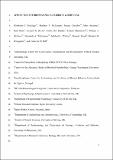Files in this item
Apes in the Anthropocene : flexibility and survival
Item metadata
| dc.contributor.author | Hockings, Kimberley J. | |
| dc.contributor.author | McLennan, Matthew R. | |
| dc.contributor.author | Carvalho, Susana | |
| dc.contributor.author | Ancrenaz, Marc | |
| dc.contributor.author | Bobe, René | |
| dc.contributor.author | Byrne, R.W. | |
| dc.contributor.author | Dunbar, Robin I.M. | |
| dc.contributor.author | Matsuzawa, Tetsuro | |
| dc.contributor.author | McGrew, William C. | |
| dc.contributor.author | Williamson, Elizabeth A. | |
| dc.contributor.author | Wilson, Michael L. | |
| dc.contributor.author | Wood, Bernard | |
| dc.contributor.author | Wrangham, Richard W. | |
| dc.contributor.author | Hill, Catherine M. | |
| dc.date.accessioned | 2016-03-31T23:01:34Z | |
| dc.date.available | 2016-03-31T23:01:34Z | |
| dc.date.issued | 2015-04 | |
| dc.identifier | 176926074 | |
| dc.identifier | 3f2d7354-85e2-4e92-81bf-a0b5ee7169d1 | |
| dc.identifier | 84925666218 | |
| dc.identifier | 000352679700007 | |
| dc.identifier.citation | Hockings , K J , McLennan , M R , Carvalho , S , Ancrenaz , M , Bobe , R , Byrne , R W , Dunbar , R I M , Matsuzawa , T , McGrew , W C , Williamson , E A , Wilson , M L , Wood , B , Wrangham , R W & Hill , C M 2015 , ' Apes in the Anthropocene : flexibility and survival ' , Trends in Ecology and Evolution , vol. 30 , no. 4 , pp. 215-222 . https://doi.org/10.1016/j.tree.2015.02.002 | en |
| dc.identifier.issn | 0169-5347 | |
| dc.identifier.other | ORCID: /0000-0001-9862-9373/work/60630532 | |
| dc.identifier.uri | https://hdl.handle.net/10023/8529 | |
| dc.description | This work was supported by a research grant to K.J.H. from FCT, Portugal (PTDC/CS-ANT/121124/2010) and from MEXT, Japan (CCSN/PWS-U04). | en |
| dc.description.abstract | We are in a new epoch, the Anthropocene, and research into our closest living relatives, the great apes, must keep pace with the rate that our species is driving change. While a goal of many studies is to understand how great apes behave in natural contexts, the impact of human activities must increasingly be taken into account. This is both a challenge and an opportunity, which can importantly inform research in three diverse fields: cognition, human evolution, and conservation. No long-term great ape research site is wholly unaffected by human influence, but research at those that are especially affected by human activity is particularly important for ensuring that our great ape kin survive the Anthropocene. | |
| dc.format.extent | 8 | |
| dc.format.extent | 1538681 | |
| dc.language.iso | eng | |
| dc.relation.ispartof | Trends in Ecology and Evolution | en |
| dc.subject | Great apes | en |
| dc.subject | Anthropogenic disturbance | en |
| dc.subject | Behavioural flexibility | en |
| dc.subject | Ape cognition | en |
| dc.subject | Hominin coexistence | en |
| dc.subject | Human–wildlife interaction | en |
| dc.subject | BF Psychology | en |
| dc.subject | GN Anthropology | en |
| dc.subject | 3rd-NDAS | en |
| dc.subject.lcc | BF | en |
| dc.subject.lcc | GN | en |
| dc.title | Apes in the Anthropocene : flexibility and survival | en |
| dc.type | Journal article | en |
| dc.contributor.institution | University of St Andrews. School of Psychology and Neuroscience | en |
| dc.identifier.doi | 10.1016/j.tree.2015.02.002 | |
| dc.description.status | Peer reviewed | en |
| dc.date.embargoedUntil | 2016-04-01 |
This item appears in the following Collection(s)
Items in the St Andrews Research Repository are protected by copyright, with all rights reserved, unless otherwise indicated.

